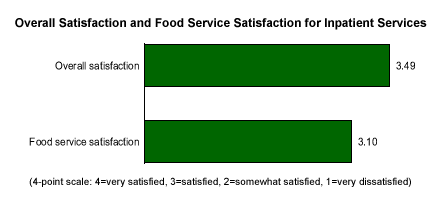What is the best way to analyze and act on inpatient satisfaction results? Consider a typical inpatient manager or supervisor who has just received the results of a patient satisfaction survey. How does he or she know what to focus on first? Because the manager has been trained as a diagnostician, a logical response for him or her would be to identify the lowest scoring item as the area of greatest opportunity for improvement and develop an action plan for improving scores on that item. Using scores from the ║┌┴¤═° inpatient loyalty database, we can take a look at how this strategy would work.
Satisfaction With Inpatient Food Service

Food service is the lowest scoring item in the ║┌┴¤═° database, and would therefore be the logical item to focus on according to the strategy described above. But food service also scores well below overall satisfaction. (Thirty-three percent of patients are very satisfied with food service, compared to 59% who are very satisfied with overall inpatient service.) This implies that, even if you find ways to increase satisfaction with food service, that increase may not have much influence on patients' overall satisfaction with their experience in a hospital.
A couple of examples will help illustrate why, in many cases, improving the quality of food may have little impact on patient satisfaction with food service
- Evaluations of the appearance of the meals may be more important than the actual quality of the food. In one instance, a nursing home received low food service scores. The root cause of these scores was traced to poor evaluations of pureed food. Quality improvements were made to the pureed food, but the scores did not improve. More research revealed that the residents were not completing the surveys -- their guardians or caregivers were. Focus group research found that pureed food was rated poorly because it looked unappetizing. When caregivers actually sampled the food themselves, they were highly complimentary of its quality.
- Fixed food service delivery schedules may have a disproportionate impact on food service evaluations. For example, a patient's meal may be delivered to his room when he is not there. Or, a patient receiving chemotherapy may be unable to eat on the fixed food delivery schedule, and may need to eat at 2 a.m. when nothing is readily available.
Hospitals may develop strategies for changing their food service systems to address problems such as these, and those strategies may successfully raise food service satisfaction scores. But the low correlation with overall satisfaction suggests that success on that specific item may not raise overall patient satisfaction scores. So how does this approach toward improving patient satisfaction fall short?
Prioritizing High Impact Items
Most hospitals don't have the resources to simultaneously focus on many different areas of quality improvement. They must prioritize, and the main goal must be to improve overall patient satisfaction and loyalty. In today's short-stay inpatient environment, food service has the lowest correlation of any of ║┌┴¤═°'s core measures with overall satisfaction (.36). This does not mean that food service should be ignored, but it does mean that other low-scoring items should be considered higher priorities.
By comparison, two other items -- "staff showing concern for the patient" and "staff treating the patient as a person, not a medical condition" -- have correlations of .64 with overall satisfaction. In general, ║┌┴¤═° finds that personal relationship issues have far more impact on overall satisfaction than process issues. Therefore, improving the quality of staff-patient interaction, rather than food service, represents a greater opportunity to improve overall satisfaction.
Key Points
The key to improving patient satisfaction and loyalty is not focusing on the lowest scoring item, but instead focusing on items that are highly related to patient satisfaction and loyalty. Management should recognize those items with high correlations and high satisfaction scores, determine the causes of success on those items, and reinforce and build upon that success. Items with high correlations to overall satisfaction and low scores should be considered targets for quality improvement.